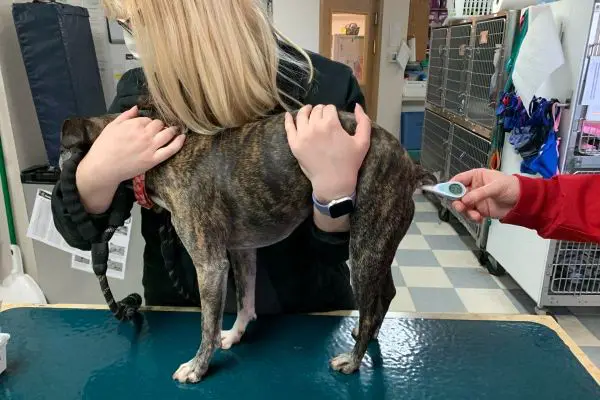Introduction
As a dog owner, it’s important to be able to recognize the signs and symptoms when your pup isn’t feeling well. Fevers in dogs can be caused by a variety of issues ranging from minor to quite serious. Being able to tell if your dog has a fever is the first step in getting them the appropriate treatment and care.
A fever indicates that your dog’s body is trying to fight off an infection or inflammation. If left untreated, fevers can lead to dehydration, seizures, and even organ damage in dogs. That’s why it’s so important to identify a fever early on and follow up with your veterinarian.
This article covers the common signs of fever in dogs, accurate methods for taking their temperature, whether feeling their nose can indicate a fever, when to call the vet, treatment options, and how to help prevent fevers from developing.
Normal Dog Temperature
The normal body temperature for dogs ranges between 100-102.5 degrees Fahrenheit (37.8–39.2 degrees Celsius). However, each dog is a little different and temperatures may vary slightly. Temperature is measured by taking the dog’s rectal temperature with a special thermometer designed for pets.

Taking a dog’s temperature rectally provides the most accurate reading of their core body temperature. The end of a dog’s rectum where the thermometer is inserted is rich with blood vessels that allow it to get a precise measurement of their body heat.
Normal canine body temperature, taken rectally, is:
- 100–102.5°F (37.8–39.2°C)
Factors like excitement, exercise, and hot environments can elevate body temperature by 1-2 degrees. As long as your dog returns to normal temperature range soon after, it is not necessarily anything to worry about.
Signs of Fever in Dogs
Some common signs that indicate your dog may have a fever include:

- Lethargy – Dogs with a fever often appear more tired and inactive than usual. They may lack interest in playing, going for walks, or other normal activities.
- Shivering – You may notice your dog shivering or trembling, as their body works to raise its temperature. Shivering helps generate heat through muscle contractions.
- Loss of appetite – A fever can cause a loss of appetite in dogs. Your dog may turn down food and treats or eat less than normal.
Other possible signs of fever in dogs are vomiting, diarrhea, a dry nose and gums, and rapid or labored breathing. If your dog is exhibiting these types of symptoms in addition to lethargy, shivering, and loss of appetite, they likely have a fever.
Taking a Dog’s Temperature
The most accurate way to take a dog’s temperature is rectally with a digital thermometer designed specifically for pets. Here’s how to properly take a dog’s rectal temperature:
- Make sure you have a digital thermometer designed for pet use. Regular thermometers for humans won’t work as well.
- Coat the thermometer tip with a small amount of petroleum jelly to help it slide in more easily.
- Gently lift your dog’s tail and position them so their rear is accessible.
- Slowly insert the thermometer about 1 inch into the rectum, stopping if you meet resistance.
- Wait for the thermometer to beep, indicating it has registered the temperature.
- Gently remove the thermometer and check the reading.
Taking a rectal temperature provides the most accurate reading of your dog’s core body temperature. Always be gentle, go slowly, and use a proper pet thermometer to avoid harming or stressing your dog.
Checking Nose Temperature
Some people believe you can tell if a dog has a fever by feeling their nose – if it’s hot and dry, the dog may have a fever. However, a dog’s nose is not an accurate way to measure their body temperature.
There is no scientific evidence that supports using a dog’s nose as a reliable method to detect fever. A dog’s nose is naturally wet and cool, designed to facilitate scent detection and heat regulation. Even if a dog’s nose feels warm, it does not necessarily indicate their body temperature is elevated.

A dog’s nose temperature can vary for many reasons unrelated to fever. Exposure to sun, exercise, stress or excitement can all raise the temperature of a dog’s nose for a short time. Certain breeds like Boxers and Bulldogs also tend to have warmer noses. Checking the nose cannot determine if the dog’s internal body temperature is raised, which is the definition of fever.
Overall, there is a lack of research and evidence that feeling a dog’s nose provides any accurate indication of their body temperature. There are no studies validating nose temperature as a reliable fever detection method in dogs. It is an unproven technique that should not replace proper temperature measurement using a vet-approved thermometer.
When to See the Vet
If you suspect your dog has a fever, it’s important to contact or see your veterinarian. An elevated body temperature often indicates an underlying illness that requires diagnosis and treatment.
Some common causes of fever in dogs include:
- Infection (e.g. urinary, respiratory, skin)
- Inflammation
- Cancer
- Immune-mediated disease
- Trauma or injury
Your vet will do a physical exam and ask about your dog’s symptoms. They may recommend blood tests, urinalysis, imaging, or other diagnostics to pinpoint the cause of the fever.
It’s important not to ignore a fever, as many illnesses that cause fever can worsen quickly without proper care. Prompt veterinary attention increases the chances of successful treatment and prevents complications.
If your dog has a fever along with lethargy, appetite loss, vomiting, diarrhea, or other concerning symptoms, seek emergency vet care right away.
While waiting for your vet appointment, you can help lower your dog’s fever by providing a cool, shaded area and wiping them down with cool water. But do not give any medications like acetaminophen, ibuprofen, or aspirin, as these can be toxic to dogs.
With veterinary guidance, most fevers can be successfully managed. Catching and addressing an illness early provides the best prognosis for your dog’s recovery.
Treating a Fever
If your dog has a fever, there are some at-home treatment options to help bring their temperature down. However, you should never give human fever reducers like acetaminophen or ibuprofen to dogs, as these can be toxic.

Some gentle, temporary options to help reduce a fever in dogs include:
- Cool (not cold) water soaks – You can soak a towel in cool water and drape it over your dog to help dissipate heat.
- Cooling mats or beds – Special dog beds and mats are designed to pull heat away from your dog’s body.
- Ice packs – Wrapping ice packs or frozen water bottles in a towel and putting them next to your dog can help cool them down.
- Hydration – Offering cool, not cold, water can prevent dehydration and temperature spikes.
- Wet food – Wet dog food contains more moisture than dry kibble, so it can help hydrate.
While these methods may provide temporary relief, it’s important to identify and address the cause of the fever with your veterinarian. Never try to manage a high fever at home without professional advice.
Preventing Fevers
One of the best ways to prevent fevers in dogs is to focus on keeping them generally healthy and well cared for. This involves several key areas:
Diet: Ensuring your dog eats a nutritious and balanced diet supports their immune system health and reduces risk of illness and infection. Feed them high quality commercial dog food and avoid table scraps or sudden dietary changes.
Exercise: Keeping your dog active and fit supports their overall wellbeing. Take them on regular walks and make time for play. An inactive, overweight dog is more prone to fevers.
Vaccines: Maintaining up to date vaccines protects your dog against many contagious and potentially serious illnesses that can cause fever, such as parvovirus and kennel cough. Follow your vet’s recommendations.
In addition to those preventative health measures, minimizing your dog’s exposure to contagious environments and promptly treating any injuries or skin wounds also helps avoid problematic infections that may lead to fever.
Other Causes of Warm Nose
While fever is one cause of a warm, dry nose in dogs, there are other reasons your dog’s nose might feel unusually warm:
-
Environmental Heat – If it’s hot outside or your home is warm, your dog’s nose may feel warmer than usual but not indicate fever. Pay attention to other signs like energy level.
-
Excitement – Some dogs get warm noses when they are excited, happy, or energetic. This is normal and not a cause for concern.
-
Sun Exposure – Direct sun exposure can heat up your dog’s nose and body temperature. Make sure they have shade and cool water.
So if your dog has a warm nose but seems otherwise normal, it may be due to heat, excitement, or sun instead of fever. Look for other fever symptoms before worrying.
Summary
In summary, while a warm or dry nose can sometimes indicate fever in dogs, a nose temperature alone is not a reliable way to check for fever. A normal canine body temperature ranges from 101-102.5 degrees Fahrenheit. Fevers are typically detected at 103 degrees or higher. Other common signs of fever in dogs include lethargy, shivering, loss of appetite and increased heart rate. The most accurate way to check for fever is by taking a dog’s rectal temperature with a thermometer. However, owners can also check armpit or ear temperatures. If a fever is suspected, especially if other symptoms are present, it’s important to contact a veterinarian, as fevers can point to infection or other underlying issues needing treatment. With prompt veterinary care and management of any illness causing the fever, most dogs fully recover. Prevention through vaccination and parasite control can also help reduce fevers resulting from contagious diseases.